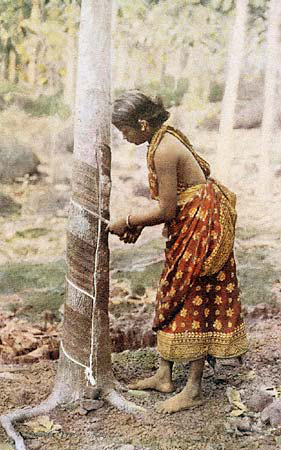Rubber tree plantation

Rubber tree seeds
In the wild, the tree can reach a height of up to 100 feet (30m). The white or yellow latex occurs in latex vessels in the bark, mostly outside the phloem. These vessels spiral up the tree in a right-handed helix which forms an angle of about 30 degrees with the horizontal, and can grow as high as 45ft.
In plantations, the trees are generally smaller for two reasons:
1) Trees grow more slowly when they are tapped for latex
2) trees are generally cut down after only 30 years, because latex production declines as trees age, and they are no longer economically viable.
The tree requires a tropical or subtropical climate with a minimum of about 1200 mm/yr of rainfall, and without frost. If frost does occur, the results can be disastrous for production. One frost can cause the rubber from an entire plantation to become brittle and break once it has been refined.
Latex tapping

Rubber tree trunk

Latex being collected from an incised rubber tree and a bucket of collected latex
Harvesters make incisions across the latex vessels, just deep enough to tap the vessels without harming the tree's growth, and the latex is collected in small buckets. This process is known as rubber tapping. Latex production is highly variable from tree to tree and across clone types.
Wood harvesting
As latex production declines with age, rubber trees are generally felled when they reach the age of 25 to 30 years. The earlier practice was to burn the trees, but in recent decades, the wood has been harvested for furniture making.
Cultivation
Rubber latex is extracted from rubber trees. The economic life period of rubber trees in plantations is around 32 years — up to 7 years of immature phase and about 25 years of productive phase.
The soil requirement of the plant is generally well-drained, weathered soil consisting of laterite, lateritic types, sedimentary types, nonlateritic red, or alluvial soils.
The climatic conditions for optimum growth of rubber trees are:
· Rainfall of around 250 cm evenly distributed without any marked dry season and with at least 100 rainy days per year
· Temperature range of about 20 to 34 °C, with a monthly mean of 25 to 28 °C
· High atmospheric humidity of around 80%
· Bright sunshine, amounting to about 2000 hours per year at the rate of six hours per day throughout the year
· Absence of strong winds
Many high-yielding clones have been developed for commercial planting. These clones yield more than 2,000 kg of dry rubber per hectare per year, when grown under ideal conditions.
Collection

A woman in Sri Lanka in the process of harvesting rubber.
In places such as Kerala (India), where coconuts are in abundance, the half shell of coconut was used as the collection container for the latex. But now glazed pottery or aluminium or plastic cups are more common in Kerala and other countries. The cups are supported by a wire that encircles the tree. This wire incorporates a spring so it can stretch as the tree grows. The latex is led into the cup by a galvanised "spout" knocked into the bark. Tapping normally takes place early in the morning, when the internal pressure of the tree is highest. A good tapper can tap a tree every 20 seconds on a standard half-spiral system, and a common daily "task" size is between 450 and 650 trees. Trees are usually tapped on alternate or third days, although many variations in timing, length, and number of cuts are used. The latex, which contains 30–40% dry rubber, is in the bark, so the tapper must avoid cutting right through to the wood, else the growing cambial layer will be damaged and the renewing bark will be badly deformed, making later tapping difficult. It is usual to tap a pannel at least twice, sometimes three times, during the tree's life. The economic life of the tree depends on how well the tapping is carried out, as the critical factor is bark consumption. A standard in Malaysia for alternate daily tapping is 25 cm (vertical) bark consumption per year. The latex tubes in the bark ascend in a spiral to the right. For this reason, tapping cuts usually ascend to the left to cut more tubes.
The trees will drip latex for about four hours, stopping as latex coagulates naturally on the tapping cut, thus blocking the latex tubes in the bark. Tappers usually rest and have a meal after finishing their tapping work, then start collecting the liquid "field latex" at about midday. Some trees will continue to drip after the collection and this leads to a small amount of "cup lump" which is collected at the next tapping. The latex that coagulates on the cut is also collected as "tree lace". Tree lace and cup lump together account for 10–20% of the dry rubber produced. Latex that drips onto the ground, "earth scrap", is also collected periodically for processing of low-grade product.
(Source: Wikipedia)
 Products
Products Expanding market demand
Expanding market demand Welcoming the cooperation
Welcoming the cooperation FACTORY Since 1999
FACTORY Since 1999


